He korero whakarapopoto
Settlements need a healthy water supply for drinking, cooking and washing, and safe ways to get rid of rubbish and sewage – otherwise diseases will spread.
Māori settlements
Māori settlements were hygienic, with special sites for toilets and for dumping rubbish, and storehouses which kept food clean. Used water was disposed of on land, not in waterways.
Early European settlements
At first, towns had no clean water supply and no safe way to deal with rubbish and sewage. Rubbish was dumped around houses and in the streets, which were littered with dung and dead animals. Used water went into open drains or waterways. In their backyards people dug cesspits – holes over which they built outhouses (toilets). Water sources were often dirty and full of germs. Infectious diseases were common, and the smells were terrible.
Toilet waste
From the 1870s the contents of toilets (called night soil) were removed at night in carts with special wooden tanks, and dumped on the edge of town. After high-pressure water supplies were introduced, cities built sewer systems – but some areas still had night-soil carts as late as the 1960s.
Water supplies
Dams were built in the hills near cities to collect water, or it was piped from rivers or lakes. In Christchurch people dug wells to access underground water. From the 1950s towns added chlorine to their water to kill bacteria – but it was often still not safe to drink.
Rubbish and recycling
In the 19th century some people hired scavengers, who collected rubbish and dumped it. Cities built huge incinerators to burn refuse. Most towns set up rubbish tips on their outskirts. These were cheap, and when full they could be covered in soil and turned into parks. But the air was polluted by burning rubbish, and toxic liquid seeped out of the tips and into waterways.
At tips today, people can compost green waste (plant and food matter) and recycle some items. In many towns people can recycle glass, plastic, cans and paper when they put their rubbish out.
Water pollution
Rivers, lakes and the sea were polluted by factories and with sewage. Wellington and the Hutt Valley were the last major centres to stop pouring untreated sewage into the sea. Water pollution was still a problem in the early 2000s.
Air pollution
In early cities coal was burnt in factories and homes, and people also burnt rubbish, polluting the air. When cars became common in the 1960s, the lead in their exhaust added to air pollution. Petrol is now free of lead. A 2007 study suggested that air pollution caused 1,100 deaths each year in New Zealand.





